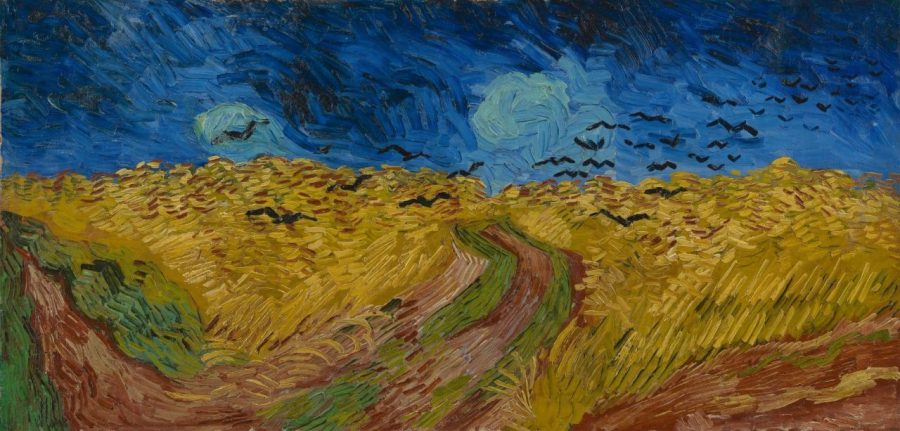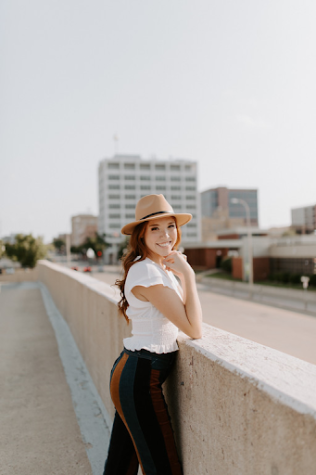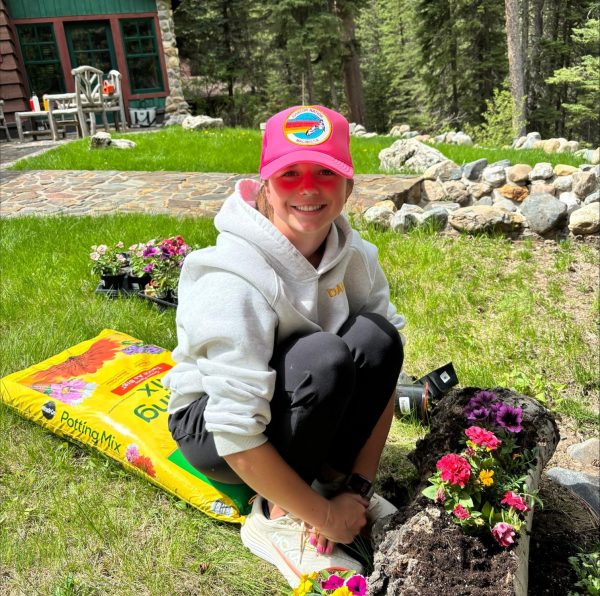Van Gogh Immersive Exhibit
“Wheatfield with Crows;” Vincent Van Gogh’s last painting which shows the wheatfield where he had taken his own life.
March 15, 2022
*content warning: suicide, self-harm
In the heart of downtown Scottsdale, Arizona lies a hidden gem. The Van Gogh Immersive Exhibit exhilarates the wondrous life and creation that Vincent Van Gogh left behind. I recently traveled to Arizona and was lucky enough to have experienced “The show of Van Gogh.”
Van Gogh was a Post-Impressionist artist whose work was solely based on the complexity of his psychological mind. Throughout his life, he and his brother, Theo shared a close relationship, which is shown in the exhibit by their frequent exchange of letters. Theo is said to have been the only one in the family to support his brother’s work. He displayed the workings of his mind through oil paintings, with his most famous painting being “Starry Night.” This masterpiece was his depicted view from his asylum room window, which was created in 1889. Van Gogh had been staying in an asylum, or today known as a psychiatric hospital, meant to serve those with mental illnesses. Depression was a battle that Van Gogh had fought too hard with. Thankfully for him, it was easiest to express the thoughts he had through his paintings, while also leaving room for new ideas.
Van Gogh’s style developed from dark to light colors quickly. In his painting, “The Potato Eaters,” he fiddled around with darker tones. But after spending time in Paris, he was heavily influenced by the light, summer tones. Alongside the lighter colors were short brush strokes and portrait paintings. He usually was the model for his portraits of people. This style did not last much longer as he quickly became sick of the city. He decided to travel to France to get his gears moving again.
While in France, Van Gogh’s spirits were lifted by the bright scenery. He still began to paint with light colors, but this time with a more free-run style. After years of being alone, a decision was made to create a “Studio of the South,” intended to house several artists and their pieces for Theo to sell. A man by the name of Paul Gauguin was the first and last artist to stay at the bright yellow, four-roomed studio. A quote from a letter that Theo wrote to him before Gauguin moved in stated, “So Gauguin’s coming; that will make a big change in your life. I hope that your efforts will succeed in making your house a place where artists will feel at home.” The bond that Gauguin and Van Gogh shared over their art was strong, but their different styles heightened tension between them. Gauguin threatened to leave and it was too much for Van Gogh to handle. The Van Gogh Museum stated, “Van Gogh became so distraught that he threatened his friend with a razor. Later that evening, he sliced off his own ear at the Yellow House, wrapped it in newspaper and presented it to a prostitute in the nearby red-light district.” The loss of his left ear marked the end of his light-colored era.
Van Gogh was then admitted to the emergency room in France. “I found Vincent in the hospital in Arles. The people around him realized from his agitation that for the past few days he had been showing symptoms of that most dreadful illness, of madness, and an attack of fièvre chaude, when he injured himself with a knife, was the reason he was taken to hospital. Will he remain insane? The doctors think it possible, but daren’t yet say for certain,” said Theo, after hearing what happened to his brother. The short stay at the emergency room was not enough for Van Gogh. Out of his own decision, he admitted himself to a psychiatric hospital, Saint-Rémy-de-Provence. His mental instability led him to stay there for a year, but it was not a time for rest. His most critical artwork was developed during the year, which was influenced by his newest sense of perception. A few of his best pieces from his hospitalization included “The Thresher,” “Window in the Studio” and “Almond Blossom.”
“. . . knowing clearly what I wanted I’ve painted another three large canvases since then. They’re immense stretches of wheatfields under turbulent skies, and I made a point of trying to express sadness, extreme loneliness. You’ll see this soon, I hope – for I hope to bring them to you in Paris as soon as possible, since I’d almost believe that these canvases will tell you what I can’t say in words, what I consider healthy and fortifying about the countryside,” Van Gogh said in the last letter that he wrote to Theo. After two months of recovery in his release from the psychiatric hospital, Van Gogh’s health mentally and physically had been at its highest since his ear incident. Staying in Paris near his brother and his family, Van Gogh was the most immersed he had ever been in his art. The connectedness he had felt between his work and self was immediately ruined after hearing the news of his brothers’ financial problems. The burden of worry of the future followed Van Gogh like a cloud chasing a sky of blue. His last letter had been written. His last words had been written. His last thoughts had been written. A wheatfield, which to him gave him comfort, was where Van Gogh took his own life. He died on July 29, 1890.
The story of this enviously talented man was pictured against the wall of the art exhibit that stood in front of me. Beside the swirly and pigmented paintings was music that closely followed the plot of his life. Pictures surrounded wherever you turned, moving fast and moving slow. As the story of this never-forgotten artist moved around me, I understood what made him oh-so-famous. Amazing stories that could never be explained in words were instead, expressed through vivid colors and images. These pieces of art have the capability to bring someone into the fictional reality that was Van Gogh’s life. It is no wonder that this exhibit has been a major hit for people of all ages, backgrounds, and lives. This was the Van Gogh Immersive Exhibit in Scottsdale, Arizona.









